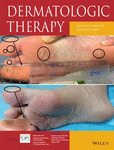Effective remission of chidamide on treatment of advanced mycosis fungoides: An unusual case report
Abstract
Mycosis fungoides (MF) and Sézary syndrome are the most common types of primary cutaneous T cell lymphoma, which primarily involves skin without curative treatment. We report a case of a 29-year-old female Chinese patient, who developed multiple cutaneous lesions gradually for 5 years. However, the patient could not tolerate pruritus and ulceration of cutaneous lesions, so she was admitted to hospital and diagnosed with advanced MF based on clinical manifestation, laboratory, and image results. Then she received four cycles of COPE regimen (cyclophosphamide, vincristine, prednisolone, and etoposide). Although the skin lesions shrinked and sense of pruritus alleviated quickly after the chemotherapy, the effective remission duration was not satisfactory. Therefore, the patient received gemcitabine and thalidomide for three cycles subsequently. Still the remission duration was not long lasting. After that, she took chidamide orally two times a week. By the time of 7 weeks, the patches almost diminished and the patient did not feel itching for almost 6 months. And, she did not have any adverse effect and had a better quality of life than the period of chemotherapy.
CONFLICT OF INTEREST
The authors declare no potential conflict of interest.




